Extreme Programming (XP) represents a software development approach that also belongs to the Agile framework. The primary focus of extreme programming in software engineering is to enhance the quality of the software being developed and meet the changing needs of the customer.
XP Programming fosters rapid release cycles and consistent interaction with different stakeholders. It also displays flexibility, which makes it very suitable for volatile environments where customer demands could change quickly. Its distinctive set of values, principles, and practices enable XP to encourage short development cycles that focus on code simplicity, as well as feedback and responsiveness to change.
This article will provide the background of XP in software engineering, its values, the main techniques applied, as well as how it differs from other Agile frameworks like Scrum or Kanban. We will also explain if XP Programming may be worth consideration for your project, focusing on the limitations and criticisms of this methodology.
The Origins and History of XP Programming
Extreme programming principles were introduced in the late 1990s by Kent Beck while he was working on the Chrysler Comprehensive Compensation System (C3) project. Beck sought to enhance the processes involved in software development due to inefficiencies in the project and late delivery that were apparent at the time.
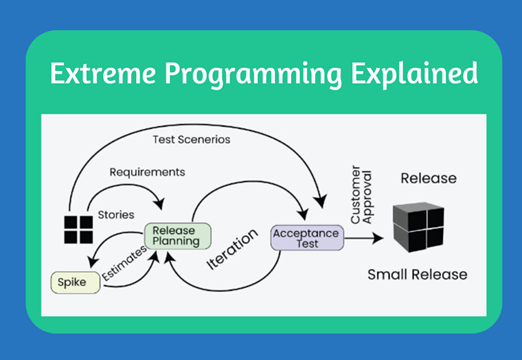
He believed that by amplifying good development practices, teams could better adapt to customer needs and produce higher-quality software.
Beck, along with other forerunners like Ward Cunningham and Ron Jeffries, widened the scope of the XP practice by articulating and developing its values, principles, and practices. XP was recognized as a usable method in the agile constellation, which was further validated and recorded by Beck in the text entitled “Extreme Programming Explained,” published in 1999.
Core Extreme Programming Values
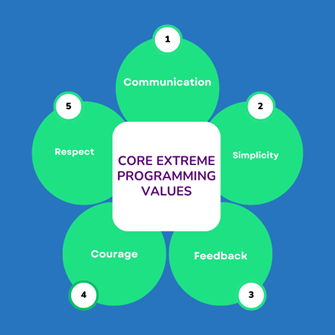
Let’s now look at the Five fundamental principles of Extreme Programming in Agile:
- Communication: Timely, truthful, and regular communication must be maintained to avoid ambiguity and ensure constant understanding of the situation at hand.
- Simplicity: Developers are to strive to write only code that is necessary without unnecessary details or complexity.
- Feedback: Regular feedback from clients and tests help the teams correct things in real time.
- Courage: Developers in XP Programming do not shy away from going the extra mile when required, including restructuring huge parts of the code base or changing parts quickly.
- Respect: All team members should respect the other team members, their views, and every contribution so that there is a culture of cooperation and collaboration.
These extreme programming values make it possible for the development teams to be focused on delivering whatever the requirements of the customers are while still remaining agile and competent in the course of the development activities.
Key Extreme Programming Practices
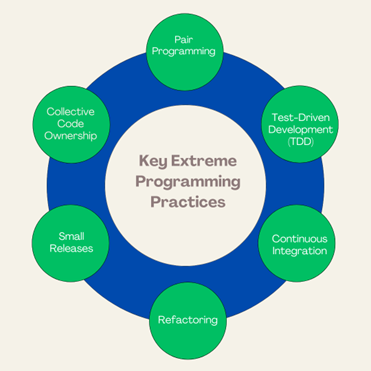
XP includes a collection of well-defined practices designed to implement its values. Here are some of the key practices:
Pair Programming
Pair programming is a hallmark of XP Agile, where two developers work together at one workstation. One developer creates the code while the other reviews it in real time, providing immediate feedback and suggestions. This XP practice improves code quality and knowledge sharing, as both programmers contribute to the solution.
Test-Driven Development (TDD)
In TDD, developers write automated test cases before writing the actual code. The idea is to define the desired behavior first, then develop just enough code to pass the tests. This XP model in software engineering leads to higher-quality software with fewer defects and better design.
Continuous Integration
Continuous Integration (CI) ensures that code changes are frequently merged into a shared repository. Each integration is automatically tested to detect and fix issues early. This XP practice reduces integration problems and ensures that the system is always in a working state.
Refactoring
Refactoring extreme programming practices involves improving the internal structure of the code without altering or impacting its external behavior. The goal is to make the code cleaner, simpler, and more maintainable. In XP Agile, refactoring is a continuous process, ensuring that code remains adaptable to future changes.
Small Releases
Extreme programming in Agile encourages small, frequent releases that deliver functional software to customers. By releasing in smaller increments, the team can gather feedback earlier and reduce the risk of major failures down the line.
Collective Code Ownership
In XP Programming, everyone on the team is responsible for the codebase. Collective code ownership ensures that anyone can make changes to any part of the system, which increases flexibility and prevents bottlenecks caused by code silos.
The XP Development Cycle
The XP development cycle is a structured process that includes four main phases:
Planning
During planning, the team collaborates with the customer to define the project’s features. The customer provides input on what’s most valuable, and developers estimate how much time it will take to complete each feature. This phase establishes priorities for the development cycle.
Designing
XP principles promote simple yet effective design. Developers aim to create the simplest solution that works and avoid over-complicating the system. Continuous design improvements happen throughout the project, especially during refactoring.
Coding
In XP practice, coding is collaborative and heavily reliant on practices like pair programming, TDD, and CI. Developers continuously test and refine their code, ensuring high quality while keeping the design simple.
Testing
Testing is a core component of the XP model in software engineering. Automated tests are created before the code itself, and these tests must pass at each stage. This ensures that new code meets the customer’s requirements and prevents regression issues.
Benefits of Implementing XP
There are several benefits to implementing Extreme Programming:
- Improved quality with cleaner, more maintainable code.
- Faster feedback through frequent releases and continuous integration.
- Allows teams to adjust to changing requirements quickly.
- Foster a collaborative, knowledge-sharing culture within the team.
- Customer satisfaction is consistently met.
Challenges and Criticisms of XP
While XP offers many benefits, it also comes with its own set of challenges:
- Cultural Shift: Extreme programming practices require a significant change in mindset, especially for teams used to traditional development models.
- Time and Effort: Practices like pair programming and TDD can initially seem time-consuming, though they lead to higher quality in the long run.
- Customer Availability: XP principles demand constant customer feedback and involvement, which may not always be feasible.
- Scalability: Some critics argue that XP’s practices work best in small to medium-sized teams, and it may not scale effectively for larger organizations.
XP vs. Other Agile Methodologies
XP shares many principles with other Agile methodologies but differs in its approach to certain practices.
XP and Scrum
XP Agile has a stronger focus on engineering practices such as pair programming and TDD. Scrum is more focused on managing the development process, with roles like Product Owner and Scrum Master. In XP Agile, these roles are less defined, and the team has more collective responsibility.
XP and Kanban
Kanban emphasizes visualizing work and limiting the amount of work in progress. XP focuses on practices like continuous testing and refactoring. XP Agile is more structured, with specific practices that teams must follow, whereas Kanban is more flexible and adaptive.
Is XP Right for Your Project?
Whether or not XP is right for your project depends on several factors:
- Team Size: The XP model in software engineering tends to work best for small to medium-sized teams. Larger teams may struggle with its highly collaborative practices.
- Project Requirements: XP Agile is ideal for projects where requirements are unclear or prone to change, as its practices are designed for adaptability.
- Customer Involvement: XP relies on frequent customer feedback. If the customer can’t commit to regular interaction, XP may not be the best fit.
Conclusion: The Future of Extreme Programming
XP has changed the landscape of the software development processes. Admittedly, it is not perfectly suitable for every project, but what XP Agile brings into software engineering is much more that it is well suited for in cases of dynamic and customer driven projects.
XP, like other Agile practices, evolves in time. Its stress on software quality allows teams to remain focused on a specific set of outcomes including XP for improving both the quality and the responsiveness of the software.
Frequently Asked Questions
What is XP?
Extreme Programming (XP) represents an Agile software development methodology. It focuses on improving software quality and responding to changing customer requirements. It emphasizes frequent releases, customer feedback, and collaborative practices. These include pair programming and Test-Driven Development (TDD).
How does Test-Driven Development (TDD) work in XP?
In XP’s TDD practice, developers write automated test cases before creating the actual code. The code is then drafted to pass the tests, ensuring that all features meet specified requirements. This approach helps to prevent defects and encourages better design.
Is Extreme Programming (XP) suitable for large teams?
XP is generally considered more effective for small to medium-sized teams. Its highly collaborative practices, such as pair programming and collective code ownership, may become more challenging to manage in larger teams.
What is the role of the customer in XP?
In XP, the customer plays a critical role by providing regular feedback and helping prioritize features. Their involvement is essential to ensure that the product aligns with business needs and evolving requirements.
Read more about Agile & Project Management here.

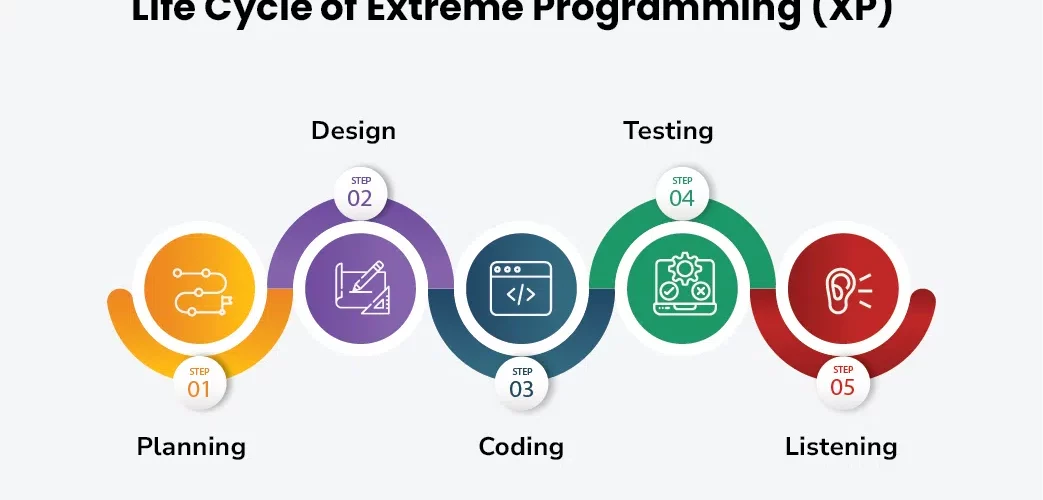
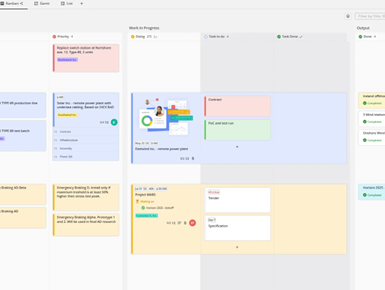
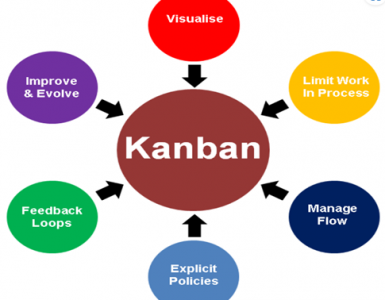
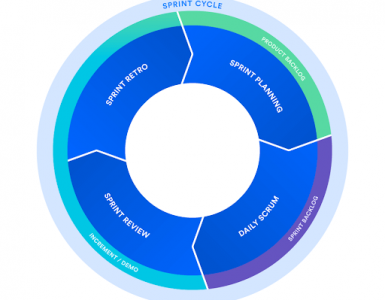

Add comment